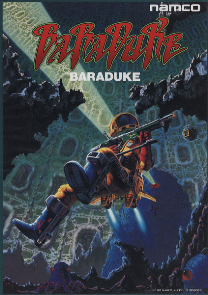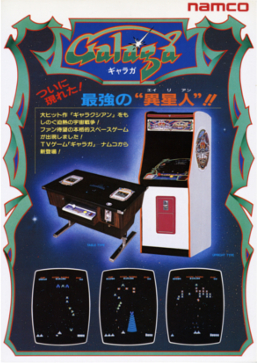
Galaga is a 1981 fixed shooter arcade video game developed and published by Namco. In North America, it was released by Midway Manufacturing. It is the sequel to Galaxian (1979), Namco's first major video game hit in arcades. Controlling a starship, the player is tasked with destroying the Galaga forces in each stage while avoiding enemies and projectiles. Some enemies can capture a player's ship via a tractor beam, which can be rescued to transform the player into a "dual fighter" with additional firepower.

Dig Dug is a maze arcade video game developed by Namco in 1981 and released in 1982, distributed in North America by Atari, Inc. The player controls Dig Dug to defeat all enemies per stage, by either inflating them to bursting or crushing them underneath rocks.

Pac-Land is a 1984 side-scrolling arcade platform game developed and released by Namco. It was distributed in North America by Bally Midway, and in Europe by Atari Games. Controlling Pac-Man, the player must make it to the end of each stage to return a lost fairy back to its home in Fairyland. Pac-Man will need to avoid obstacles, such as falling logs and water-spewing fire hydrants, alongside his enemies, the Ghost Gang. Eating large flashing Power Pellets will cause the ghosts to turn blue, allowing Pac-Man to eat them for points.

Mr. Driller is a puzzle video game franchise created by Yasuhito Nagaoka and Hideo Yoshizawa for Namco. The eponymous first game was released in 1999 for arcades and several home consoles, such as the PlayStation. Gameplay in the series consists of controlling Susumu Hori, the titular Mr. Driller, or one of his friends and destroying colorful formations of blocks to make it to the bottom of a well. In order to survive, players need to collect air capsules to replenish their depleting oxygen and avoid being crushed by falling blocks.

The Tower of Druaga is a 1984 arcade action role-playing maze game developed and published in Japan by Namco. Controlling the golden-armored knight Gilgamesh, the player is tasked with scaling 60 floors of the titular tower in an effort to rescue the maiden Ki from Druaga, a demon with eight arms and four legs, who plans to use an artifact known as the Blue Crystal Rod to enslave all of mankind. It ran on the Namco Super Pac-Man arcade hardware, modified with a horizontal-scrolling video system used in Mappy.
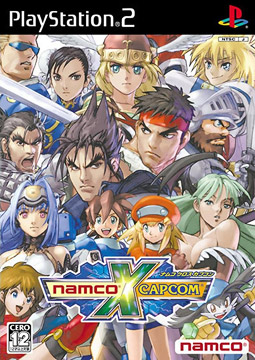
Namco × Capcom is a tactical role-playing (RPG) crossover video game developed by Monolith Soft for the PlayStation 2 and published by Namco in 2005. The gameplay combines tactical RPG and action sequences during battles, featuring characters from video game series owned by Namco and Capcom. The narrative sees original characters Reiji Arisu and Xiaomu, operatives for paranormal investigative group Shinra, confront distortions bringing characters from other realities into their own.

Dig Dug II is an action arcade video game developed and published in Japan by Namco in 1985. It is a sequel to 1982's Dig Dug. Pookas and fire-breathing Fygars return as the enemies, but the side view tunneling of the original is replaced with an overhead view of an island maze.

Legendary Wings is a fantasy-themed shoot-'em-up / platformer arcade video game released by Capcom in 1986. The player takes control of a young soldier equipped with magical wings who must save the world from a malfunctioning supercomputer. A home version for the Nintendo Entertainment System was released exclusively in North America in 1988. The original coin-op version is included in Capcom Classics Collection for PlayStation 2 and Xbox and in Capcom Classics Collection Remixed for PlayStation Portable.

Galaga '88 is a 1987 fixed shooter arcade video game by Namco. It is the third sequel to Galaxian. It features significantly improved graphics over the previous games in the series, including detailed backgrounds, larger enemies and greater ship details. The game runs on Namco System 1 hardware.
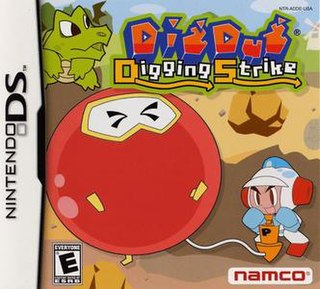
Dig Dug: Digging Strike is a 2005 maze video game published by Namco for the Nintendo DS. In Europe, the game was published by Atari Europe. It is the fifth entry in the Dig Dug video game series, and the second to be made for a home platform. The game follows series protagonist Taizo Hori, bitter about his son Susumu getting more attention than him—after a chain of tropical islands is threatened by monsters, Taizo sets out to defeat them and reclaim his fame. Gameplay combines mechanics established in the original Dig Dug and its sequel Dig Dug II, centered around sinking a large "boss" character into the ocean by digging under large stakes in the ground.

Bakutotsu Kijūtei, also known by its longer title as Bakutotsu Kijūtei: Baraduke II, is a scrolling shooter arcade game that was released by Namco in 1988 only in Japan, and for the Virtual Console in 2009. It runs on Namco System 1 hardware, and is the sequel to Baraduke, which was released three years earlier. It was also the second game from the company to allow scores not ending in "0", along with the first one to display Katakana in bold text onscreen to distinguish it from Hiragana. The game would later be ported to the Wii Virtual Console in 2009 for Japan only.

Dragon Spirit is a 1987 vertical-scrolling shooter arcade game developed and published by Namco. In North America, it was distributed by Atari Games. Controlling the dragon Amul, the player must complete each of the game's nine areas to rescue the princess Alicia from the demon Zawell. Similar to Namco's own Xevious, Amul has a projectile weapon for destroying air-based enemies and a bomb for destroying ground enemies. It ran on the Namco System 1 arcade board.

Namco Classic Collection Vol. 2 is a 1996 compilation arcade game developed and published by Namco. It is a collection of four of Namco's popular games: Pac-Man (1980), Rally-X (1980), New Rally-X (1981) and Dig Dug (1982). Alongside the original games, three new "Arrangement" games based on each game are included.
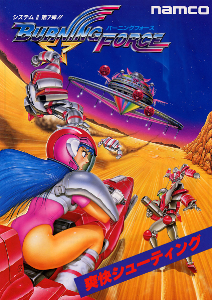
Burning Force is a 1989 third-person shooter arcade game developed and published by Namco in Japan. A home conversion for the Sega Genesis was released worldwide a year later. The player assumes control of the woman space cadet Hiromi Tengenji, a pilot training to become a member of the Space Force, who must complete each level by shooting down enemies with her airbike and avoiding projectiles. Gameplay is similar to Space Harrier, featuring a fixed camera position behind the player and having similar mechanics. It runs on the Namco System 2 arcade hardware.

The Return of Ishtar is an action role-playing arcade video game released by Namco in 1986. It runs on Namco System 86 hardware and is the sequel to The Tower of Druaga, which was released two years earlier. The game's story directly starts after the first game, where Ki and Gil must venture down in the Tower of Druaga and escape it. It is the second game in the company's Babylonian Castle Saga series, and was later ported to the MSX, NEC PC-8801, FM-7, and Sharp X68000 platforms. The Return of Ishtar was included in the compilation game Namco Museum Volume 4 for the PlayStation, which is also the first time the game had been released overseas.

Section Z is a horizontally scrolling shooter by Capcom, released as an arcade video game in 1985. A home version was published for the Nintendo Entertainment System in 1987.

Mr. Driller W is a 2009 puzzle video game developed and published for the WiiWare service by Namco Bandai Games. The eighth entry in the Mr. Driller series, gameplay revolves around clearing each level by destroying, or "drilling", large formations of colorful blocks. Players have an oxygen meter that acts as a time limit, and constantly depletes; air is replenished by collecting air capsules, and is depleted further by destroying brown "X" blocks.

Star Trigon is a 2002 puzzle arcade game published in Japan by Namco. Ports for iPod, iOS devices and Windows were also released. In the game, the player controls one of three characters — Wataru Hoshi, Chuta Bigbang and Susumu Hori — the objective being to rescue creatures known as "Uchijins" by hopping from planet to planet to draw triangles and capture them. The player will automatically circle the planet they are on, requiring timed jumps to avoid falling off the playfield. It ran on the Namco System 10 hardware.

Mr. Driller is a 1999 puzzle arcade game developed and published by Namco. Versions for the PlayStation, Dreamcast, Microsoft Windows, Game Boy Color, WonderSwan Color, mobile phones, and iOS were also released. Controlling Susumu Hori, the titular "Mr. Driller", the player must dig their way to the bottom of the screen by destroying colored blocks that litter the playfield. Blocks will be cleared if four or more are touching each other, which can be used to cause chain reactions. Susumu has a constantly-depleting oxygen meter that can be refilled by collecting air capsules found throughout stages.

Mr. Driller G is a 2001 puzzle arcade game developed and released in Japan by Namco for its System 10 hardware. It is the third installment in its Mr. Driller series, and the last released for arcades. Controlling one of seven characters, players must make it to the bottom of the level by destroying colorful formations of blocks. G introduces several new ideas to the series, such as power-ups, a story campaign, and online multiplayer.
